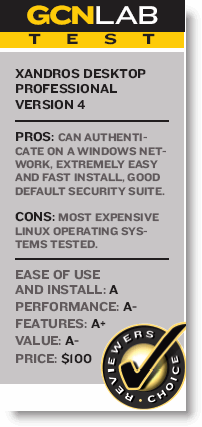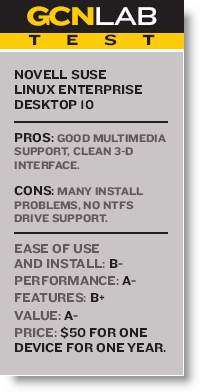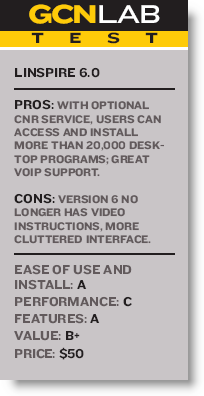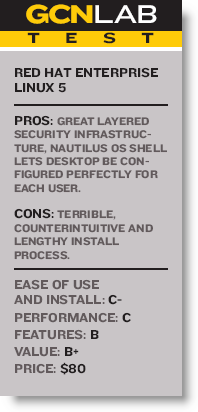Linux operating systems are like a box of chocolates: You never know what you're going to get. OK, that's a bad pop culture reference, but it's true. Our latest look at the Linux desktop operating systems contains everything from stale, coconut-like bonbons to rich, soft dark chocolate treats. And with so many varieties of Linux operating systems to choose from, finding the best for your agency can be a hassle.In the past, I would have started this roundup by telling you that before choosing a new operating system, you need to understand why you need one ' especially if you want a Linux or Unix hybrid. This disclaimer had been true because, until recently, even the most common Linux platform required some programming knowledge to operate effectively. So I would have recommended that you make sure your agency had personnel trained to handle the operating system.However, within the past five years, Linux designers have made strides in creating an interface that is more intuitive, standard and user-friendly.Additionally, Mac OS X's popularity has grown in recent years to the point where many users are no longer seeing a Windows-based platform as the only way to live and work, and subsequently, people are less intimidated by different operating system environments.One of the best operating systems in this roundup, Xandros, offers the ability to switch the interface to resemble Mac OS X or Windows XP.These changes in operating systems, coupled with an increasingly tech-savvy workforce, are changing the 'Microsoft only' landscape on a daily basis. At my own office, I have recently noticed the water cooler talk gravitating more toward root issues ' and Linux or Mac tools as opposed to .dll horror stories and future service pack wishes. As our findings in this review demonstrate, a lot of Linux manufacturers are challenging Microsoft by producing solid, desktop versions of their operating systems.We reviewed four of the most popular Linux operating systems and judged them on ease of use and installation, performance, functionality and price. The functionality and performance grades were straightforward. We hooked seven peripheral devices to each operating system, including three printers, to see if they could automatically detect and install the hardware. We then tracked how long it took to install the hardware to analyze performance. The base computer for the review is a 1.7- GHz Pentium M Panasonic CF-51 with 512M of RAM and a 40G hard drive.The scores for the operating systems in this review ran from average to great in the ease of use and installation category and average to good in the performance and functionality categories. And as you would expect, the prices are unbeatable, particularly when you will soon need a home equity line of credit to purchase the next Windows operating system, not to mention Office applications.Xandros was a clear winner in most categories, offering the fastest and easiest installation at an unbelievable 5 minutes, 15 seconds starting from a blank slate. The toughest installation was a close race between Novel SUSE Desktop 10, which kept displaying compression errors throughout the process, and Red Hat, which did not want to install at any level without prior programming knowledge. It took a couple of hours to finally get Novel up and running, and I had to call on a very Unix/Linux-savvy friend to get Red Hat working. I clocked Red Hat at three days because my buddy was out of town for the holidays ' that is overstating it, but you get the idea.PAST VERSIONS OF Xandros have been good. It's a well-known adaptation of the KDE flavor of Linux that has always concentrated on working with Microsoft. Unlike any other version of Linux in this roundup, Xandros not only operates some Microsoft software ' mainly Office ' but it also plays nice with the Microsoft NTFS file allocation system. Xandros users can now read and write to NTFS drives. Xandros can authenticate with Microsoft Windows networks so you can use it as a node on a fully Windows network. It can even share files and printers with other Windows machines.During the installation, we were pleased to see that Xandros' default installation mode doesn't replace other operating systems, but modifies the size of any existing partitions and installs beside them. We had Microsoft Vista on our Panasonic test computer, and Xandros detected the other operating system and automatically added Microsoft and Xandros' Desktop Professional Version 4 to the boot screen.Unlike every other Linux operating system in this review except for Linspire, I had no problem getting Xandros to use my Netgear wireless router to access the Internet ' Xandros being the more effortless of the two. It was as easy getting Xandros to join my encrypted wireless network as it was with Windows XP or Mac OS X. Simply double-click on the wireless icon on the bottom right of the toolbar and select your network. Then it will prompt you for the encryption key and you're done.The Xandros Security Suite is surprisingly robust, easy to use and does not require an extra subscription fee. The suite found a host of generic viruses I have collected and quarantined from past e-mails and deleted every attempt to damage the operating system or related files. Additionally, the firewall, which can be modified in the Security Suite interface, is easy to use because it is designed like the firewall in Windows XP.Another aesthetically pleasing quality of Xandros is its ability to switch to many different modes so if you're a Mac or GNOME user you can operate in a familiar environment. This level of organization, which makes getting used to Xandros so effortless, is enhanced by the fact that Xandros doesn't come with a closet full of cluttered applications, as most Linux flavors do. You can find the most important apps more easily than in Linspire, and you feel more comfortable in the Xandros environment than with Red Hat.Version 4 of Xandros also is the most futuristic-looking Linux flavor in the review, mostly because of AIGLX, which allows for 3-D desktop effects such as those commonly found in Microsoft Vista, only without the need for a high-end graphics card. Xandros has an effective Desktop Search tool ' like Leopard and Vista ' that kept the desktop easy to use no matter how cluttered I tried to make it.Xandros comes standard with a Virtual Desktop feature, which I have grown to like at work. Microsoft Windows has a Virtual Desktop Manager, but it must be downloaded from a Web site and is not native to the Windows operating system. In Xandros, clicking one of the two colored squares in the lower right corner of the main desktop takes you to a new Virtual Desktop that lets you make use of more desktop real estate. For example, you could open your Web browser and e-mail client on a blue desktop, change to a green desktop, and open and arrange your word processor and spreadsheet. Xandros lets you turn on as many as 16 desktops.A unique feature in Xandros Version 4 is Bluetooth support and expanded mobile Internet device support that includes Global System for Mobile Communications, Universal Mobile Telecommunications System and 3G wireless networks.Lastly, Xandros comes with new application updates for some critical Linux apps, such as the Mozilla Firefox 2.0 Web browser, OpenOffice.org 2.0.3, and Evolution 2.6.3. The $100 price is the highest in this review, but with Xandros it's a case of getting what you pay for. It earns our Reviewer's Choice designation for having a well-rounded, secure and easy-to-use interface. DESPITE THE SEEMINGLY endless flavors of Linux, there are two main types: those geared for novice to intermediate users, and those geared for intermediate to advanced users. Novell SUSE Linux Enterprise Desktop 10, like Red Hat's version, falls into the latter category. Xandros and Linspire resemble Microsoft, which makes them easier to use if you are new to the world of Linux but generally intolerable to an advanced Linux user.Nevertheless, the two breeds of Linux are highly comparable. Their main differences are in desktop and navigational appearances, but they all perform the same core function of an operating system ' to act as the intermediary between the user and the machine.Being a native of the Windows environment who was trained to use Unix and Linux, I always dreaded stress testing and reviewing the more advanced versions of Linux because it took more time and effort than the simple point, click, plug and unplug world of a Windows-like graphical user interface. That changed when I encountered Novell SUSE Linux Enterprise Desktop 10. From top to bottom, this is the most modern and powerful version of Novell Linux we have seen. A lot of the advances can be attributed to the clean look of the 3-D graphics SUSE 10 now uses.Novell also does a great job of keeping programs, such as OpenOffice.org, Firefox Web, Evolution collaboration tools, Gaim instant messenger, and other accessories well-organized in menu tabs. SUSE Linux Enterprise Desktop also has preinstalled features such as Beagle, which integrates an effective desktop search engine for finding files and data.Another good feature is out-of-the-box media capabilities such as Banshee music management, F-Spot photo-library management and Tomboy note application.One feature we'd hoped to see with Novell SUSE Linux Enterprise Desktop 10 was some Microsoft interoperability, particularly the ability to use Office and other Microsoft programs.However, I had a hard enough time installing Novell on my Panasonic with a version of Vista already installed.The repeated errors I got trying to install Novell 10 gave it the longest install time in the roundup, 135 minutes. It kept stalling on the formatting drive section of the install, saying that it could not delete and load the NTFS partition that Xandros was able to install next to. Finally, I had to manually format the entire drive and install Novell from scratch. It would be a great improvement if Novell could not only format on a NTFS partition but also give the user the ability to repartition the drive to fit both operating systems and dual-boot with Windows.On the plus side, SUSE Linux Enterprise Desktop 10 only costs $50 for one machine for one year and includes the option of creating an AutoYaST profile at the end of the install. In lay terms, you can create a clone of the operating system with the desired configuration on the network or a separate drive during the installation. This is great if you're a network administrator because then all you have to do is AutoYaST to a network drive and then map every additional computer to that network path. Then you can install and set up as many nodes as you want regardless of location.IN THE PAST, LINSPIRE has produced some of the most user-friendly Linux operating systems.And although the latest version takes a step in the right direction with some of its features, this Ubuntu-based Linux flavor falls short of what we had expected from the 'easiest Linux OS in the world.'Linspire starts with a base installation of Ubuntu, which is Debian-based, and then adds proprietary drivers, codecs and software.For additional software, Linspire uses CNR (Click-N-Run), a Linspire service that lets you choose from more than 20,000 additional programs for free.CNR also acts as a software update feature for the operating system.Despite these solid features ' and a simple installation that was finished in 8 minutes, 10 seconds ' Linspire has moved away from some of the old features we liked. We most missed the video instructions that guide you through the interface, with which Version 5.0 wowed crowds new to Linux. Version 6.0 can leave you feeling as though you're stranded on a desert island where you have to explore and learn how to survive. This feeling is compounded by a cluttered, disorganized experience when navigating through the desktop and menu options looking for applications and files.The visual graphics and bells and whistles that made Linspire 5.0 a hit seem to be missing in this newer version. One example is the lack of the 3-D desktop that the other review participants boast. This makes a huge difference in the feel and efficiency of navigating the operating system. Additionally, small things such as wallpaper and screen shots appear flat and stale.Linspire comes preloaded and ready to support MP3, Real Player, QuickTime, Windows Media, Java and Flash along with OpenOffice.org.2.2, which includes Microsoft file-compatible word processing, spreadsheet and presentation software. Linspire offers the new Open Extensible Markup Language for bidirectional compatibility, so files saved in Open XML can be opened by OpenOffice. This increases the interoperability so you can easily read and share files between platforms.Linspire wisely offers Gizmo Project voiceover- IP software, which lets you talk all over the world with no long-distance phone charges. As a result, users can call computer to computer, set up conference calls and check voice mail for free. Outside land-line calls are also possible for as little as a penny per minute.You are only paying $50 per client to begin with, so this is a great added value.However, these great features raise a dangerous point that is important to understand if you're considering using Linspire in your agency. A lot of features that come embedded in many Linux operating systems may pose a security risk, depending on your policies. If you use Linspire 6.0, for example, features such as Gizmo and even CNR may need to be removed from every node. This can amount to a lot of added tedium for the network administrators who have to install the systems.We recommend that Linspire consider segmenting its product to include a security-focused or hardened version of future models as an option for the government environment.WHEN A COMPANY drags its feet on submitting a product for review, it usually is trying to hide something. In the case of Red Hat, it's the installation process for Enterprise Linux 5, which is atrociously complex compared with the other operating systems in this roundup. If everyone else can create a good installation process, Red Hat should be able to do the same.The other products in this review had a simple two-step process for initiating the installation of the software: insert disk and reboot computer. These and many other basic steps apparently eluded Red Hat designers, who seem to want to keep making a product that few people would want to ever use, much less tempt them to migrate from a Microsoft Windows environment. And those who want to move to Linux at work will, and should, choose something more friendly, such as Novell and Xandros.Now that I've got that out of my system, let's move on to what I liked about Enterprise Linux 5. This operating system is a step in the right direction, with stringent security features that would please the toughest government offices. Additionally, the graphical desktop includes a file manager called Nautilus that provides a graphical display of your system and personal files. What we liked about this feature ' and which differentiates it from the other graphical desktop search engines ' is that Nautilus is designed to be much more than a visual listing of files. It allows you to configure your desktop and configure your Red Hat Linux system in the way that works best for you.For example, I tailored Nautilus to more efficiently browse my extensive photo collection.However, the cool thing about Nautilus is that access to my network resources remained unchanged and easy to control. Red Hat describes Nautilus as a shell for your entire desktop experience, and it is the best-built subprogram of the operating system.I only wish the rest of this operating system were as easy to use. For example, to start Nautilus as a file manager, simply double-click on your home directory icon. Then you can navigate through your home directory or the rest of the file system.Select the Home button to return to your home directory, and that's it.Nautilus also revamped security features with a layered defense scheme for keeping desktops secure, protection against commonly exploited security flaws such as buffer overflows and smartcard authentication support. These features kept the ease of use and installation grade from dropping below C because security is a critical government issue that Red Hat handles well. But it was still close. However, for a list price of $80, Red Hat Enterprise Linux 5 is an expensive program that should be a little easier to use and especially easier to install. If the program does not install properly, what else about it really matters
Xandros Desktop Professional Version 4









